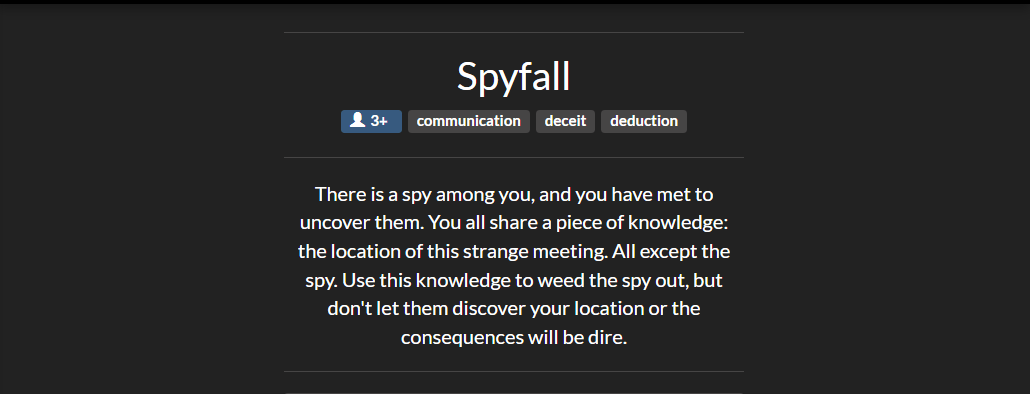
Spyfall is a strategic social deduction game that is typically played in one round, where among the players exists one spy. This unilateral party game involves social evaluation, creates sneaky dynamics amongst players, and ultimately involves two victory conditions for both the spy, or the general members playing against the spy. The premise of Spyfall is that there exists one spy within the group of individuals, who does not know the location that this mysterious meeting is happening; the spy must try to guess where the meeting is happening, whereas players are trying to guess who amongst them is the spy by identifying players who do not seem to know the location. During the round, players have 3 minutes to take turns questioning other players about the location, and at the end of the round, players have to vote on who they believe the spy is. Meanwhile, the spy is trying to guess the location based off of the questions that others are asking; if the spy correctly guesses the location, they automatically win, even though they are voted out at the end of the round. The other win condition for the spy is that they are not voted out, meaning that they successfully fooled the other players.

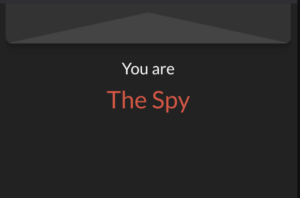
Spyfall was designed by Alexandr Ushan and published by Hobby World; it was originally published as a card game, but is now hosted on online platforms such as on netgames.io/games/spyfall/. The target audience of the game is said to be players ages 12+, but I believe the game can be played with players as young as 8. This game is targeted towards a more general audience due to its simple nature and procedures. Furthermore, because this game has a minimum of 3 players and can accommodate up to 12 players, it functions perfectly as a party game that is played amongst groups of people in social settings. I played this game on the online platform above with 4 other people.
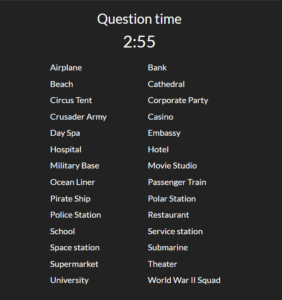
One game mechanic that is particularly interesting in Spyfall is the openness of the turn-based questioning that happens during the round, which emphasizes the social deduction aspect of the game. This mechanic of Spyfall is particularly important because of the formal element of this game’s objectives. The most clear objective of players is to identify the spy, and the most obvious way for players to identify the spy would be to ask direct questions about the location to identify which players don’t know this location. However, there’s an alternative objective for the players: not letting the spy know what the location is. Because of the interplay of these two objectives, players are forced to formulate the perfect, ambiguous questions to ask each other in order to deduce who the spy is while also being careful as to not reveal the location. For example, during my gameplay, my little brother tried asking the question: “What letter does this location start with?” to another player to be able to single out if they were a spy, but the outcome of the situation was that the person was not a spy, and the spy was able to easily guess what the location was. Hence, these objectives of the main players also make it easier for the spy to blend in with the crowd, and achieve their own objective of trying to find out the location. In other discussion-based spy identification games like Mafia, the discussion components are without constraints in that obtaining information from others usually doesn’t have to be ambiguous or as strategic, as it does in SpyFall. Ultimately, because all the other players have the “resource” of the location of the meeting, and the spy doesn’t, it is in the best interests of the player to gatekeep this resource while also attempting to identify the spy.
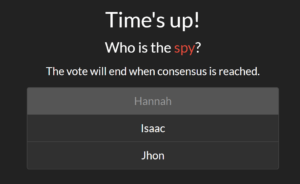
Another interesting game mechanic of Spyfall is the existence of only one round; players only have 3 minutes to identify who the spy is, so the outcome of the game is entirely dependent on the discussion that happens in these 3 minutes. Hence, players are forced to think quickly to formulate pointed questions to figure out which player is the spy; this time constraint forces players to make quick social deductions and adapt their questions as others ask questions. This game mechanic is quite different from other social deduction games such as mafia or Among Us, where players have multiple “rounds” or opportunities to identify who the spy is. In these games, players can use the process of elimination to eventually narrow down the suspects for the spy; this is something that is entirely absent from SpyFall. As the number of players increase in SpyFall, it also becomes more difficult to gather enough information to identify who the spy is. In addition, because of this time constraint, as a player, I found it becoming increasingly difficult to keep track of information while also trying to form strategic questions. During the times I played as a spy, it also became quite difficult to keep track of all the information players provided about the location to narrow down which location.
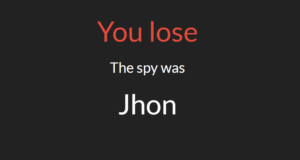
Some critiques I have of the game arose from my experience while playing it. I played this game multiple times with the same 4 people, and one critique that arose from us all was just how quick the game was. The 3 minute time constraint seemed a bit tight even for 5 players, and would definitely be the case as the number of players increased. One way to improve the game would be to increase the length of the round, maybe to 5-6 minutes, especially since the game finishes within one round. Another situation that arose during my gameplay was that some of the questions ended up being very situational based on your existing relationship with the other player. For example, I would ask my sister if she had been in this location, with the location being a circus, fully knowing that she had not been to one, and sometimes these kinds of personal questions would cause the game to end early. These types of questions would reduce the level of social deduction that I had to complete to access the win condition. It could be interesting to introduce a new constraint that the questions had to be generalized rather than bringing a person’s experience in it to make the game last longer and force players to think of more interesting questions about the location itself to ask.
Overall, this game was an engaging game of social deduction that required more strategic and on-the-go thinking from players. It quickly creates a narrative between players in its storyline and also subtly relies on the aesthetic of fellowship between players to single out who the spy is. Due to its simplicity, it allows players to focus solely on the social deduction component of the game; its formal elements solely focus on the players, the objectives, and the subsequent outcomes. Because of its carefully created objectives that have the potential to hinder one another and the interesting player dynamic that its mechanics create, SpyFall comprises a successful and nuanced social deduction game.


